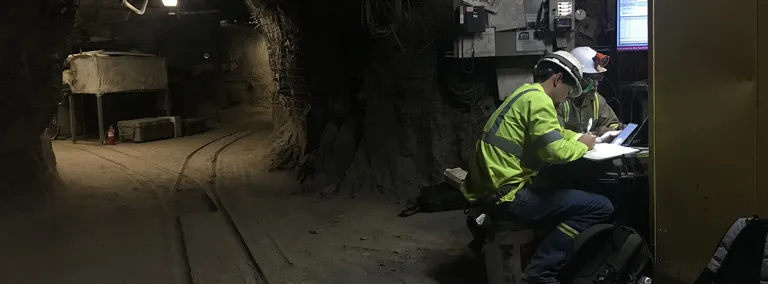Spearfish educator ushers SURF data into his classroom
For 31 years, Stephen Gabriel has brought real-world datasets into his Spearfish High School classroom
Stephen Gabriel stepped onto the Ross Cage at the Sanford Underground Research Facility (SURF), ready to travel 4,850 feet below the surface. Others shuffled onto the conveyance, lining the walls and setting equipment and lunch boxes on the floor between their feet. At the operator’s radio request, the cage began to descend. Gabriel looked across the cage and noticed a familiar face. “Richard Hovdenes?”
Hovdenes glanced up. “Yes?”
“It’s Mr. Gabriel,” he said, extending a hand.
Hovdenes’s face lit up with recognition and shook his hand. “Mr. Gabriel! What’s it been? Ten years?”
“Just about.”
Hovdenes chuckled, “Well, I still use those unit conversions every day, so thank you for that!”
A decade before this cage ride, Hovdenes was a student in Gabriel’s physical science class, apparently mastering unit conversions. Today, he is a mining engineer with Thyssen Mining Company, working on the excavation of massive caverns for what will be the largest particle physics experiment on U.S. soil.
Seeing former students isn’t unusual for Gabriel, who has taught physics and physical science at Spearfish High School for 31 years. But running into a former student on an elevator to the underground? That was a first.
Real-world science in the classroom
The chance meeting was also a small validation of Gabriel’s teaching ethos, which centers real-world problem solving in the classroom. “Students come to understand science as something they do for an hour and a half every other day, three days a week,” Gabriel said. “But that’s not how science works. Science is 24/7/365.”
Gabriel himself became interested in the sciences because of an experience he had. While in college, he built an insulated box for a research group studying the ozone layer in Antarctica. “I became interested in science because of that one experience,” Gabriel said. “I've tried to pay the system back and do whatever I can to give students memorable experiences.”
Gabriel’s search for local science to bring into the classroom is exactly what brought him to SURF. For the last ten years, Gabriel has been studying how the facility breathes.
Underground airflow at SURF is critical for many reasons. It keeps the temperature from rising; it vents exhaust from diesel-powered excavation equipment; it creates a quieter background for science; and, most importantly, it provides breathable air.
At a glance, ventilation at SURF is quite simple: Fresh air flows down the Ross and the Yates shafts (the two main access shafts), across the horizontal levels, then up and out the Oro Hondo and Five shafts. But, as you zoom in, tracking airflow across hundreds of miles of drifts, ramps, and shafts becomes quite complex. Pressures change. Surface temperatures fluctuate. Air doors are opened and closed. New caverns are excavated. And each change influences the path and pace of airflow.
Gabriel built a system to track and monitor this airflow using ten “weather stations” strategically placed underground. Five stations are located on the 4850 Level, where much of the science activity takes place. Five others are installed on the 800, 1700, 2000, 4100, and 5000 levels. These ten stations give Gabriel a steady drip of data on temperature, humidity, velocity, and barometric pressure at each location.
The live influx data is a boon to Gabriel’s classroom. When airflow fluctuates, Gabriel and his students tease apart the datasets to reconstruct the physics at play behind this complex system. But the data is also providing real-world solutions for SURF’s infrastructure and engineering teams.
“These weather stations really help us figure out what’s going on underground, without having to physically go to each place and take measurements,” said Jason Connot, the underground operations engineer tasked with monitoring SURF’s ventilation. “This is important in the case of an emergency or a power outage. Even without underground access, we can look at this system and understand how much air we are getting in different areas.”
Creating experiences in science
Gabriel uses Spearfish High School’s mentorship program to recruit students who want to take a deeper dive into his ongoing research at SURF. These students spend several semesters studying ventilation data and mastering the data collection systems. Then, after turning 18 years of age (a requirement for traveling underground), they can join Gabriel for an underground survey trip.
“Once a student has an underground experience, it’s unlike anything else. Those are the experiences I’m trying to give back,” said Gabriel, who estimates that he has brought at least 50 students underground to date.
Gabriel’s research goes beyond the ventilation project. He’s served as local science support for research groups studying seismicity at SURF and continues to advance his pedagogy expertise through such programs as Research Experiences for Teachers, QuarkNet, and SURF’s summer professional development programs for K-12 educators.
“Steve is driven to make sure that he stays on the cutting edge of research, and he delivers that to his students, providing them with incredible opportunities up at the lab,” said Chad Ronish, SURF science education specialist.
Gabriel’s enthusiasm for science has become a quasi-worldview: “When I look at the world, I see science everywhere.” And thanks to his work in and out of the classroom, his students can, too.
